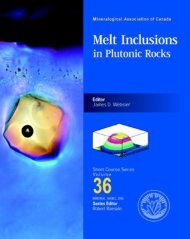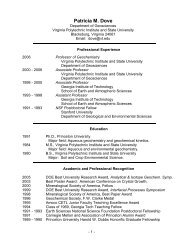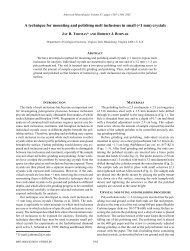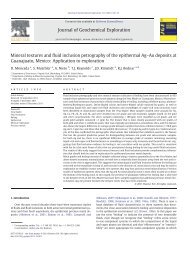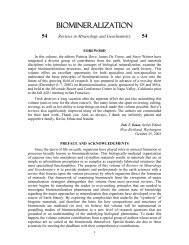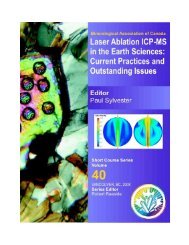Biomineralization Within Vesicles: The Calcite of Coccoliths
Biomineralization Within Vesicles: The Calcite of Coccoliths
Biomineralization Within Vesicles: The Calcite of Coccoliths
Create successful ePaper yourself
Turn your PDF publications into a flip-book with our unique Google optimized e-Paper software.
<strong>Biomineralization</strong> <strong>Within</strong> <strong>Vesicles</strong> 203micrometer to atomic scale and with these observations have established the preciserelationships between element morphology and crystal lattice (Fig. 5; Henriksen et al. inpress a). High resolution AFM <strong>of</strong> the flat surfaces <strong>of</strong> the elements (Fig. 5B and D) revealan atomic pattern identical to that known from rhombic {10¯14} faces <strong>of</strong> inorganic calcite(Stipp et al. 1994; Stipp 1999). It shows the characteristic surface unit cell, atomic rowsdefining the orientation <strong>of</strong> the a-axis vector, and a pairing <strong>of</strong> these rows that constrainsthe crystallographic orientation fully (Henriksen et al. in press a). C. pelagicus has{10¯14} faces on the whole distal shield surface and has element edges defined byrhombic cleavage (Fig. 5E), with individual elements stuck together by imbrication. Bycontrast, in O. fragilis the crystal lattice is rotated so that acute crystallographic cornersmake the complex element edges. This enables elements to interlock without overlap,allowing for very thin and delicate coccoliths (Fig. 5F). <strong>The</strong> outer part <strong>of</strong> the distal shieldconsists <strong>of</strong> rhombic faces that are broken by a series <strong>of</strong> steps forming the slope towardsthe middle, probably induced by constraints on growth space by the vesicle. Thus, in bothspecies the rhombic calcite motif is much in evidence, but detailed variations inorientation allow them to construct coccoliths with very different properties.An example <strong>of</strong> the importance <strong>of</strong> the interplay <strong>of</strong> rhombic growth directions withvesicle geometry is provided by comparing coccoliths <strong>of</strong> the closely related speciesCalcidiscus leptoporus, Umbilicosphaera foliosa and Umbilicosphaera sibogae (Fig. 8).<strong>The</strong>se belong to the family Calcidiscaceae and have their distal shields entirely formedfrom V-units (Young 1998; Young et al. in press). Calcidiscus leptoporus (Fig. 8A)shows flat, overlapping elements with curved radial edges. <strong>The</strong> surfaces are almostcertainly rhombic calcite faces, as can be seen from overgrown specimens, fromexamination <strong>of</strong> face relationships in the central area, and by analogy with the relatedspecies Coccolithus pelagicus and Oolithotus fragilis. Umbilicosphaera sibogae (Fig.8B) is similar, but has a wider central opening and radial edges showing a pronouncedkink. Umbilicosphaera foliosa (Fig. 8C) also has flat, probably rhombic faces, but hastwo cycles in the shield. <strong>The</strong> inner cycle is imbricated clockwise, the outer is imbricatedcounter-clockwise, with both cycles showing crystallographic edges. Superficially, this isa very complex crystal structure. However, when a large number <strong>of</strong> specimens isinvestigated at high resolution, paying close attention to overgrown and malformedexamples, it becomes evident that both shield cycles are made up <strong>of</strong> the same crystalunits. This is illustrated in Figure 9. <strong>The</strong> crystal units actually have a rather simple basicshape, as indicated by the dotted lines on Figure 9B, which also reflect the shape <strong>of</strong> theelements on the proximal surface. This simplicity is in marked contrast to the apparentcomplexity on the distal surface, caused by counter-clockwise growth on the surface <strong>of</strong>the crystal in the outer part <strong>of</strong> the coccolith and clockwise growth in the inner part. <strong>The</strong>difference in growth direction is in fact a predictable result <strong>of</strong> the plane <strong>of</strong> the crystalsurface intersecting obliquely with a conical surface (Fig. 9C). This is not seen in C.leptoporus since the elements are less obliquely oriented, and there are fewer <strong>of</strong> them.Figure 8D shows a specimen <strong>of</strong> U. foliosa with rather irregular growth that has thecomplete range <strong>of</strong> element types, from simple elements like those typical <strong>of</strong> C.leptoporus, through kinked elements like those <strong>of</strong> U. sibogae, to the <strong>of</strong>fset bicyclicelements typical <strong>of</strong> U. foliosa. <strong>The</strong> fact that all three can occur on one coccolith as aresult <strong>of</strong> malformation proves that no major changes in mechanism are necessary to formone rather than the other. Further, this suggests that the range <strong>of</strong> distal shield elementmorphologies seen in the three species arise as a product <strong>of</strong> interaction <strong>of</strong> crystalorientation and coccolith shape rather than through any direct control <strong>of</strong> crystal growth.This example is thought-provoking because it shows that in biomineralization, a trivialchange in process can result in a large morphological effect.



